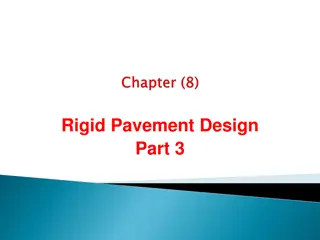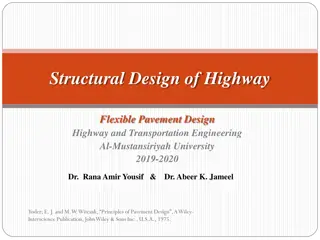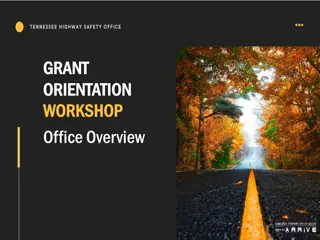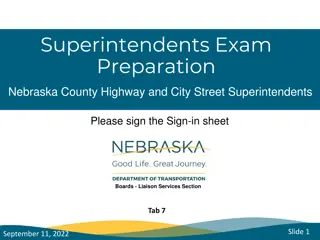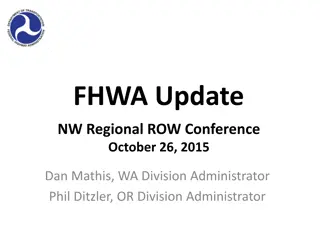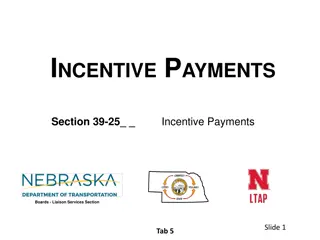AASHTOWarePMED UserGroup Design Challenge #2 Instructions
Instructions for Design Challenge #2 include gathering into assigned groups, opening PMED 3.xx web application for analysis, selecting templates, working on layer thicknesses and material types, inputting traffic and climate data, and selecting design properties for jointed and continuously reinforc
6 views • 15 slides
Rigid Pavement Design: Stresses and Joint Types
Stresses due to temperature variation can affect concrete slabs, causing warping and friction stresses. Proper joint design, including expansion, contraction, and construction joints, is crucial to minimize stress and prevent warping in concrete pavements. This guide explores different types of join
4 views • 9 slides
Public Meeting for S.D. Highway 63 Improvement Project in Dewey County
Public meeting scheduled for Thursday, Jan. 11, 2023, at 5:30 p.m. MST to involve the community in planning and designing improvements for S.D. Highway 63 in Dewey County. The meeting aims to gather input on the proposed project, project limits, background information, traffic data, crash history, h
0 views • 23 slides
Principles of Traffic Demand Analysis and Highway Demand Forecasting
Understanding traffic flows is crucial in designing highways and managing traffic effectively. Traffic demand analysis involves forecasting future traffic volumes, modeling demand, and determining the necessary infrastructure improvements. This analysis helps in estimating axle loadings, pavement th
0 views • 36 slides
AASHTO Method for Highway Flexible Pavement Design
The AASHTO method for highway flexible pavement design is based on the AASHO Road Test results and has been revised over the years to provide guidelines for pavement structural design. It emphasizes performance period, time constraints, and design variables to ensure long-lasting and cost-effective
1 views • 25 slides
Proposed FY 2022 Highway Program Amendment Summary
The Federal Infrastructure Bill, Infrastructure Investment and Jobs Act (IIJA) was passed, providing $550 billion in funding for transportation. The bill includes reauthorization of surface transportation programs from FY 2022 to FY 2026. Changes to projected funds for FY 2021 projects and adjustmen
0 views • 8 slides
Geometric Design of Highway Vertical Curves and Criteria
This content covers the vertical alignment in transportation engineering, focusing on the geometric design of highway facilities, specifically vertical curves like crest and sag curves. It explains the main design criteria for vertical curves, including minimum stopping sight distance provision, dra
2 views • 24 slides
AASHTO Method for Determining Effective Roadbed Soil Resilient Modulus
The AASHTO method provides a systematic approach for evaluating the effective roadbed soil resilient modulus in flexible pavements. It involves calculating the relative damage to pavements based on predicted traffic load and allowable load repetitions. The method considers the seasonal moduli values
0 views • 30 slides
Guidelines for Design of Cement Concrete Pavement and Interlocking Paver Blocks
This document provides guidelines for designing cement concrete pavements and interlocking paver blocks, covering factors governing design, wheel loads, design period, subgrade characteristics, approximate k values based on CBR values, and the importance of a sub-base below concrete pavements. It em
0 views • 67 slides
Kentucky's Highway Plan Development and Improvement Overview
Kentucky's highway plan involves capturing needs and translating them into projects, with a focus on larger highway improvement projects like safety improvements, road widening, reconstruction, new interchanges, and routes. The process includes project development planning to address operational and
0 views • 6 slides
Importance of Regular Parking Lot Sweeping in Property Maintenance
Regularly sweeping parking lots is crucial for asset management, risk reduction, environmental compliance, and aesthetics. Sweeping helps prevent wear and tear on pavements, extends the life of sealcoat and striping, reduces liability risks, manages stormwater efficiently, and controls rodent infest
0 views • 6 slides
AASHTO Pavements Working Group Meeting Overview
The AASHTO Pavements Working Group meeting from July 18, 2011, covered various topics including self-introductions, research updates, NCHRP and TRB updates, FHWA Transportation System Preservation Roadmap, and SCOM vision and mission. Discussions were held on membership details, meeting locations, a
0 views • 22 slides
- "Development of Pavement-Specific Structural Synthetic Fibers - TAP Meeting Insights
- The TAP meeting on the development of pavement-specific structural synthetic fibers held on November 3, 2021, highlighted key benefits of fibers in pavements, such as increased load transfer efficiency and reduced cracking. Various industry partners and experts discussed the participation of fiber
0 views • 42 slides
2018 Maintenance Update: Snow & Ice Management and Pavements Maintenance
The 2018 maintenance update includes discussions on snow and ice management issues such as salt usage, contract truck problems, vendor salt deliveries, cave salt deliveries, and available dashboards for data monitoring. Additionally, preventive maintenance programs related to pavements have seen sig
0 views • 14 slides
Pavement Engineering Overview: Types, Design, and Requirements
A comprehensive overview of highway pavement engineering, covering types of pavements, structural requirements, ideal pavement characteristics, and classifications into flexible, rigid, and composite pavements. Proper pavement design is crucial for ensuring long-lasting, safe, and high-quality road
0 views • 19 slides
Introduction to Rigid Pavement Design in Highway Engineering
Rigid pavements, made of cement or reinforced concrete slabs, are designed to resist traffic loads by distributing them over a wide area of soil. The design focuses on providing a structurally strong concrete slab. Minor variations in subgrade strength have little impact on rigid pavement capacity,
0 views • 13 slides
Advanced Highway Information Extraction Interface
Explore the HIVEi highway information extraction interface presented at the Statewide Transportation Planner Meeting in 2018. Learn how to select and extract data on highway systems, roadway features, pavement conditions, traffic information, bridges, and more. Discover the detailed process and capa
0 views • 14 slides
Roadside Safety Gore Points: Highway Work Caution
Working on highway shoulders requires utmost caution and awareness due to the dangers posed by passing traffic. Participants must always face traffic, be vigilant of potential obstacles, and avoid entering gore points. These traffic decision points demand extra attention as motorists enter or exit h
0 views • 5 slides
Subarea and Highway Corridor Studies: Travel Demand Modeling and Refinements
In this lesson, we delve into subarea and corridor studies focusing on travel demand model refinements, highway network coding, corridor congestion relief, and trip assignment theory. Subarea modeling plays a crucial role in forecasting travel within smaller regions with detailed traffic patterns, t
1 views • 45 slides
Bipartisan Infrastructure Law - Overview of Highway Provisions
This presentation provides an overview of the highway provisions in the Bipartisan Infrastructure Law (BIL), also known as the Infrastructure Investment and Jobs Act. It focuses on significant programs and provisions related to highways, offering insight into budget authority, contract authority, ob
0 views • 73 slides
Chapter 1 Study Guide: Driving, Mobility, and Highway Safety
Explore the comprehensive study guide for Chapter 1, covering topics such as driver education benefits, personality's impact on driving, car insurance insights, mandatory insurance in New Jersey, and the role of the National Highway Safety Act in ensuring road safety. Delve into the potential conseq
0 views • 9 slides
Governors Highway Safety Program Overview
The Governors Highway Safety Program (GHSP) in Vermont has undergone a change in venue, now operating under the newly established Highway Safety Office at the Agency of Transportation (AOT). This strategic restructuring aims to enhance collaborative efforts and streamline highway safety initiatives
0 views • 48 slides
Highway Advisory System (HAS) Pilot Project for Safer and Faster Travel on NH8
The Highway Advisory System (HAS) Pilot Project on the Delhi-Jaipur NH8 aims to provide real-time information on congestion, weather conditions, safety awareness, and disaster warnings to ensure safe and hassle-free travel on National Highways. The project encompasses phases focusing on construction
0 views • 9 slides
Tennessee Highway Safety Office Overview & Funding Details
The Tennessee Highway Safety Office (THSO) plays a crucial role in implementing statewide programs focused on highway safety, including occupant protection, impaired driving, speed enforcement, and more. Established in 1967, THSO administers federally-funded programs following the federal fiscal yea
0 views • 16 slides
Ohio State Highway Patrol - Images Collection
Explore a collection of images showcasing the Ohio State Highway Patrol. From official vehicles to officers in action, these images capture the essence of the Ohio State Highway Patrol's work and dedication. Scroll through to get a visual glimpse of this law enforcement agency in action.
0 views • 9 slides
Nevada Department of Transportation Overview
The Nevada Department of Transportation (NDOT) is responsible for the planning, construction, operation, and maintenance of the state highway system, which includes over 5,400 miles of highways and 1,000 bridges. NDOT is funded through state highway funds and federal funds without utilizing any gene
2 views • 16 slides
Strategic Highway Safety Plan Update 2020 Review
Strategic Highway Safety Plan (SHSP) is a multi-agency effort to reduce traffic fatalities and injuries on public roads, mandated by federal law. The plan must be updated every five years to utilize Highway Safety Improvement Program (HSIP) funds. Ohio Department of Transportation (ODOT) receives si
0 views • 8 slides
Effective Pavement Management Program Overview
This program by the Pennsylvania Department of Transportation focuses on the importance of implementing preventive maintenance strategies at the right time for highway pavement management. It covers topics such as types of pavements, preventive maintenance concepts, treatment selection, and timing f
0 views • 14 slides
Climate Models and Moisture Equilibrium in Flexible Pavement Design
Climate inputs like temperature and moisture play key roles in flexible pavement design. The heat transfer model evaluates frost action and temperature regimes, while moisture equilibrium models consider the interaction between soil suction and moisture content. Understanding these factors is crucia
0 views • 13 slides
Re-Alignment of US 17 in Zolfo Springs with Concrete Pavements Project Overview
The project involves realigning a segment of US 17 in Zolfo Springs, Florida, improving corridor safety and infrastructure. Contractor Ajax Paving Industries will construct a concrete roadway with bike lanes, sidewalks, and stormwater management systems. The old US 17 will become Main Street for Zol
0 views • 28 slides
Comparison of Kentucky Highway Fatality Rates Across Multiple States
Analysis reveals Kentucky's highway fatality rates in comparison to other states over the years 2005, 2013, 2014, and 2015. Data from the National Highway Traffic Safety Administration (NHTSA) shows variations in fatalities per 100 million vehicle miles traveled, positioning Kentucky among the state
0 views • 29 slides
Transforming Dixie Highway Project Overview
The Transforming Dixie Highway project aims to address existing conditions on Dixie Highway, focusing on highway improvements, bus rapid transit, and intelligent transportation systems. Key components include crucial partnerships with transportation entities, extreme challenges such as physical cons
0 views • 13 slides
Overview of Nebraska County Highway and City Street Superintendents Exam Preparation
This content provides detailed information on the preparation for the exam for Nebraska County Highway and City Street Superintendents, including topics such as Highway Law, State Oversight & Support by Regulatory Boards, and the duties and responsibilities of the Board of Public Roads Classificatio
0 views • 11 slides
Understanding Truck Size and Weight Impacts on Highways
The presentation delves into the interdependent aspects of truck weight - axle weight and Gross Vehicle Weight (GVW) - on highway infrastructure, emphasizing their impacts on pavements and bridges. It also discusses industry challenges related to Truck Size and Weight (TS&W) limits and their effects
0 views • 38 slides
Federal Highway Administration Updates and Regulatory Processes Overview
This content covers updates from the Federal Highway Administration (FHWA), including the NW Regional Right-of-Way Conference in 2015, the federal rule-making process, agency regulatory updates, and changes in CFR regulations. It also discusses proposed highway bill reauthorization acts such as the
0 views • 16 slides
Incentive Payments and Distribution in County Highway Management
The information provided outlines the purpose, process, and factors involved in incentive payments for appointing licensed superintendents to manage road or street programs in counties. It details the conditional duties of appointed county highway superintendents and factors determining the amount o
0 views • 18 slides
Geometric Design Principles for Highway Routes
This content discusses the application of geometric design principles in highway route design, focusing on preliminary route layout, defining design controls, and establishing initial alignments. Key factors such as minimum radius of curves, vertical curve length, maximum grades, intersection approa
0 views • 28 slides
MAP-21 Performance Measures for Pavements and Bridges Overview
MAP-21, a federal transportation funding bill, established a performance-based program focusing on national transportation goals to increase accountability and transparency. The program emphasizes key areas such as safety, infrastructure condition, congestion reduction, system reliability, freight m
0 views • 23 slides
Illinois Highway Program Funding Overview
The Illinois Highway Program funding overview covers various aspects such as federal funding, state revenues, local funding, legislative appropriations, and distribution points. It highlights the importance of appropriations for implementing the highway program and details specific fund allocations
0 views • 36 slides
Update of Crash Modification Factors for Highway Safety Manual
This project, led by the University of North Carolina Highway Safety Research Center, focuses on updating Crash Modification Factors (CMFs) for the Highway Safety Manual (HSM). The team aims to assess and develop criteria for CMFs, conduct gap analysis, develop crash modification functions for treat
0 views • 36 slides

